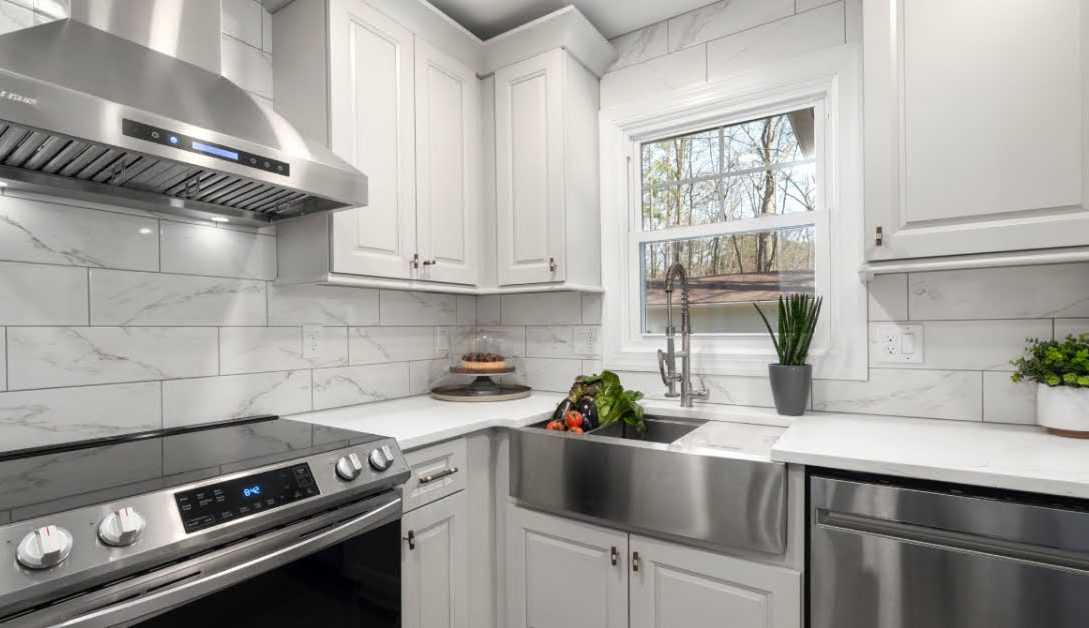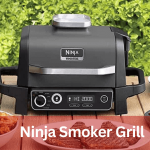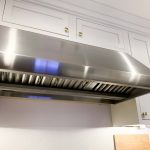Ducted range hoods exhaust air outside while ductless ones recirculate it back into the room. Ducted range hoods are often more effective at removing cooking smoke and odors, but ductless hoods are simpler to install and can be a more affordable option.
Range hoods are an essential part of any kitchen, especially for those who often cook with high heat or strong-smelling ingredients. The two primary types of range hoods are ducted and ductless, each with its own unique benefits. Ducted hoods require a ventilation system to expel air outside, while ductless hoods filter and recirculate air back into the kitchen.
In this article, we’ll explore the differences between the two and help you decide which type of range hood might be best suited for your kitchen needs.
What Are Ducted Range Hoods?
Ducted range hoods are a popular type of appliance that is used to extract smoke and other types of airborne pollutants generated from cooking. They work based on a relatively simple concept that involves capturing contaminated air from the kitchen and then venting it outside through a duct.
In this section, we will define ducted range hoods and explain how they work, highlight the benefits of using them compared to their ductless counterparts, and identify essential factors to consider before selecting a ducted range hood.
Definition And Explanation Of How Ducted Range Hoods Work
A ducted range hood is a ventilation system that is mounted above a stove or cooktop with a connection to a duct that expels air outside. This type of range hood has various components, including a fan, motor, filters, and ductwork that work together to ensure that airborne smoke, steam, and other contaminants generated during cooking are safely removed from the kitchen.
The primary function of the ducted range hood is to draw in the contaminated air and expel it outside through a vent located in the roof or wall. This method of ventilation ensures that pollutants, such as carbon monoxide and other volatile organic compounds, do not accumulate within the home and pose a risk to human health.
Benefits Of Using Ducted Range Hoods In Comparison To Ductless
Here are some of the benefits of using ducted range hoods compared to their ductless counterparts:
- Efficiency: Ducted range hoods are more efficient than ductless ones because they do not recirculate air within the kitchen. Instead, they vent it out, which means that contaminants do not linger in the air and are instead expelled outside, ensuring clean air quality within the kitchen.
- Reduced cooking odors: Ducted range hoods remove smoke and cooking odors by exhausting them outside the house, which means the cooking smells do not linger and spread throughout the house.
- Better air quality: With a ducted range hood, the air within the kitchen is continuously filtered, ensuring that it remains clean and healthy.
- Increased value: Ducted range hoods can increase the value of a house due to their efficiency and the clean air they provide. They are also more aesthetically pleasing compared to ductless ones.
Factors To Consider Before Choosing A Ducted Range Hood
When choosing a ducted range hood, it is essential to consider the following factors:
- Size: The size of the range hood should match the size of the stove or cooktop. This ensures that the hood exhausts the right amount of air and captures all the pollutants generated during cooking.
- Ductwork: The ductwork size should be consistent with the range hood and the type of cooking equipment being used. It should also have a straightforward path outside to ensure efficient ventilation.
- Noise level: Ducted range hoods can be noisy because of the motor. It is essential to choose a model that has a low noise level but still performs efficiently.
- Filters: The filters are an essential component of a ducted range hood. They need to be reasonably easy to remove and clean or replace regularly.
- Aesthetics: Ensure that the range hood complements the kitchen’s design and architecture.
Ducted range hoods are a popular appliance used in many kitchens globally. They are an excellent investment for households that prioritize clean air quality, efficient ventilation, and maintaining a high home value. When choosing a ducted range hood, ensure that it matches your kitchen’s style, stove size, noise level, duct size, and filter characteristics.
What Are Ductless Range Hoods?
Definition And Explanation Of How Ductless Range Hoods Work
If you’re not familiar with ductless range hoods, they’re kitchen ventilation systems that don’t require any ducts to function. These range hoods utilize charcoal filters to trap grease, odors, and smoke before returning the air to your kitchen. This process ensures that the air quality in your kitchen remains fresh and healthy to breathe.
Here’s how ductless range hoods work:
- A ductless range hood is mounted over your stovetop, either by screws or bolts, and connected to a power source.
- When you cook, steam, smoke, and odors are extracted through a series of filters placed within the range hood.
- These filters trap the pollutants and contaminants, thus purifying the air and neutralizing any unpleasant smells before recirculating it in your kitchen.
- Because ductless range hoods don’t expel air outside, it provides a more energy-efficient alternative and easier installation process.
Benefits Of Using Ductless Range Hoods In Comparison To Ducted
Ductless range hoods boast many advantages over their ducted counterparts. They not only provide adequate ventilation but are also easy to install, making them a popular choice among homeowners. Here are some benefits of using ductless range hoods in comparison to ducted:
- Ductless range hoods don’t require any ductwork, meaning they can be installed without the need for additional structural changes. This reduces installation costs and makes them ideal for retrofitting older homes.
- They provide a more energy-efficient ventilation solution, as the air is recirculated back into the kitchen. This eliminates the need for external ventilation ducts, resulting in lower energy bills.
- Ductless range hoods come with a variety of filters, including charcoal filters, which eliminate foul odors effectively. This results in a healthier living environment with fewer pollutants and overall improved air quality.
- As ductless range hoods don’t rely on external venting, they offer more flexibility in terms of placement. This means you can install them in any location that’s convenient for you, including kitchen islands, without the need for external venting.
Factors To Consider Before Choosing A Ductless Range Hood
Before buying a ductless range hood, several factors must be taken into account to ensure you opt for the right one. Here are some critical factors to consider before choosing a ductless range hood:
- Filtering criteria: Because ductless range hoods rely on filters to purify the air, you must consider the type and quality of filters included. It’s crucial to ensure you choose a range hood that comes with efficient filters like charcoal filters. The quality of filters will dictate the efficiency and effectiveness of your range hood.
- Sizing: It’s equally important to opt for a range hood that matches your stove’s size; otherwise, it won’t be able to perform optimally. Make sure to measure the stove’s size and select a compatible range hood that complements it perfectly.
- Sound level: Ductless range hoods work by recirculating air back into your home, meaning they produce a significant amount of noise. Therefore, consider the range hood’s sound level and choose one with noise levels below 60 decibels (db).
- Ventilation rate: As mentioned earlier, ductless range hoods come with different filters, how effectively the range hood traps undesired air depends on the ventilation rate of your range hood. Hence, it’s essential to choose a range hood with a high ventilation rate than less ventilation rate that will ensure high-quality air.
How Do You Choose The Right Range Hood For Your Kitchen?
Comparison Of Ducted And Ductless Range Hoods
Range hoods are necessary appliances in any kitchen since they help maintain the air quality by eliminating smoke, moisture, and unwanted odors. However, choosing the right type of range hood can be challenging if you don’t know the differences between the two types of range hoods.
Here is a comparison of ducted and ductless range hoods:
- Ducted range hoods require ductwork that vents to the outside, while ductless range hoods have filters that recirculate air back into the kitchen after being filtered.
- Ducted range hoods are typically more efficient in removing cooking smoke, steam, and grease than ductless range hoods.
- Ductless range hoods are easier to install since they don’t require ductwork, making them less expensive than ducted range hoods.
Considerations Of Kitchen Layout, Cooking Habits, And Budget When Choosing A Range Hood
Selecting the appropriate range hood for your kitchen involves a series of considerations such as kitchen layout, cooking habits, and budget. Here are a few factors to consider before buying:
- Kitchen layout: Determine the size and layout of your kitchen since it will help determine the size of your range hood. If you have a large kitchen, you’ll need a larger range hood to help eliminate cooking smoke and moisture.
- Cooking habits: Consider the frequency and variation of cooking in your kitchen. If you cook several meals a day, you may need a range hood with higher airflow capacity and a more powerful motor to remove the smoke and steam faster.
- Budget: Range hoods are available in various price brackets, ranging from economical to expensive. Set your budget and choose the best range hood that fits your budget without compromising quality.
Professional Advice On Selecting The Best Range Hood For Your Kitchen
Choosing the ideal range hood for your kitchen can be a daunting task since there are so many options available on the market. Seeking professional advice enables you to make an informed decision. Here’s what to consider when selecting the best range hood for your kitchen:
- Ensure the range hood has enough suction power to accommodate your kitchen size and specific needs.
- Consider the level of noise you can tolerate since some range hoods can be noisy, especially those with high suction power.
- Determine the size of the range hood you need based on the size and layout of your kitchen.
- Choose the type of venting you prefer, whether it’s ducted or ductless range hood.
Selecting the best range hood for your kitchen is vital in maintaining a clean and fresh-smelling kitchen. By following the tips provided above, you can choose the most fitting range hood for your kitchen based on your specific needs.
Installation And Maintenance Of Ducted And Ductless Range Hoods
Installing a range hood is an essential step to achieving a smoke-free and odorless kitchen. There are two types of range hoods on the market: ducted and ductless range hoods. Understanding the difference between the two will help you make a better decision based on your needs and budget.
In this section, we will discuss the installation and maintenance of ducted and ductless range hoods, including a step-by-step guide for both types.
Step-By-Step Guide To Installing A Ducted Range Hood:
Installing a ducted range hood requires more work and effort than installing a ductless range hood. A ducted range hood vents the air outside through ductwork. Here is a step-by-step guide on how to install it:
- Select an appropriate location for the range hood, considering the size of the exhaust fan, the width of the cooktop, and the ceiling height.
- Determine the venting path and location of the ductwork. Install the ductwork from the range hood to the outside of the house without any bends or kinks.
- If there is no existing ductwork, drill a hole on the wall or roof to install the ductwork. Make sure to seal the hole around the ductwork.
- Attach the range hood to the wall or cabinet using screws and mounting brackets.
- Install the electrical wiring and connect it to the range hood.
- Attach the ductwork to the range hood and the outside vent using screws, duct tape, or clamps.
- Test the range hood to ensure proper airflow and functioning.
Step-By-Step Guide To Installing A Ductless Range Hood:
A ductless range hood does not require any ductwork, making it easier to install and more affordable. However, it requires more frequent cleaning and maintenance. Here is a step-by-step guide on how to install it:
- Choose an appropriate location for the range hood, considering the size of the exhaust fan, the width of the cooktop, and the ceiling height.
- Mount the range hood to the wall or cabinet using screws and mounting brackets.
- Install the charcoal filters by removing the covers and securing them in place.
- Install the ductless vent kit or recirculating vent if needed.
- Install the electrical wiring and connect it to the range hood.
- Test the range hood to ensure proper airflow and functioning.
Best Practices For Maintaining And Cleaning Both Types Of Range Hoods:
Maintaining and cleaning your range hood regularly will ensure its longevity and efficient functioning. Here are some best practices for maintaining and cleaning both types of range hoods:
- Clean the filters frequently, depending on the frequency of use. Charcoal filters should be replaced every three to six months.
- Clean the exterior and interior surfaces of the range hood with a mild cleaner and a soft cloth.
- Check the ductwork for any clogs or damages and clean or repair them accordingly.
- Test the range hood periodically to ensure proper airflow and functioning.
- Avoid using abrasive cleaners or steel wool, which would scratch the surface of the range hood.
- Ensure that the range hood is turned off while cleaning it.
Installing and maintaining ducted and ductless range hoods require different levels of effort and planning. Keep these best practices in mind to make the most of your range hood and ensure its durability and efficient functioning.
Frequently Asked Questions Of What Is The Difference Between Ducted And Ductless Range Hoods
What Is A Ducted Range Hood And How Does It Work?
A ducted range hood vents air outside your home using a duct system. It pulls steam and smoke through the ducts and releases them outside through an exhaust fan. This type of range hood is ideal for homes with high cooking activity to maintain a fresh air supply.
What Is A Ductless Range Hood And How Does It Work?
A ductless range hood purifies and recirculates the air in your kitchen after trapping grease, odors, and smoke. This range hood doesn’t require a duct system, thus making installation simpler. It uses charcoal filters to purify the air before releasing it back into the kitchen.
Which One Is More Powerful, Ducted Or Ductless Range Hood?
Ducted range hoods are more powerful compared to ductless ones as they rely on a vent to circulate air straight out of the kitchen. On the contrary, ductless range hoods purify and recirculate the air using an internal motor and filter system, which makes them less effective in terms of air extraction.
How Much Does It Cost To Install A Ducted Range Hood?
Ducted range hood installation costs vary between $300 to $1800. The actual cost depends on the installed range hood’s complexity, ductwork, and the distance to the outside vent. The labor cost of the installation is another factor to consider, alongside the cost of materials such as metal ducts, screws, and hangers.
How Much Does It Cost To Install A Ductless Range Hood?
The installation cost of a ductless range hood is typically lower than a ducted range hood, between $200 to $1500. This is due to the lack of an external duct system which significantly reduces the installation process’ complexity and time.
The cost may vary depending on the type of range hood and labor cost for installation.
Conclusion
Choosing between a ducted or ductless range hood ultimately depends on your needs, budget, and personal preference. Ducted hoods have traditionally been the go-to choice for their efficient performance, but ductless hoods have made strides in recent years thanks to advancements in technology.
While ductless hoods are often less expensive and easier to install, they can be less effective at removing smoke, odors, and grease from the air. Ducted hoods, on the other hand, require more space and typically involve more installation costs but offer superior ventilation.
Ultimately, it comes down to what works best for you and your kitchen. Consider the layout of your kitchen, the type of cooking you do, and your budget when deciding which range hood is right for you. With the right choice, you can enjoy a clean, fresh-smelling kitchen free of smoke and cooking odors.

Freda is a passionate foodie and kitchen gadget enthusiast. With over 10 years of experience in the culinary industry, Freda brings her expertise in testing and reviewing kitchen gadgets.





